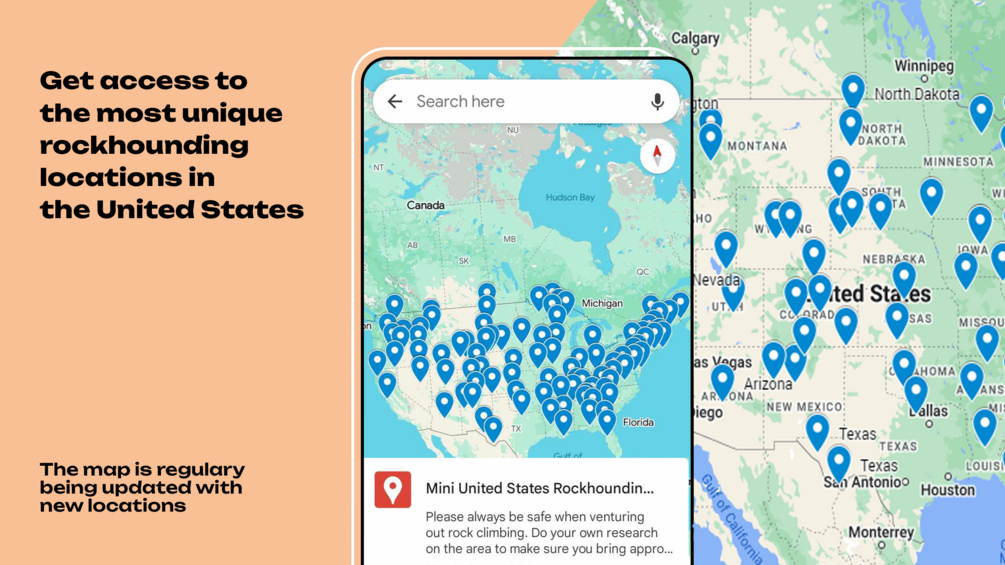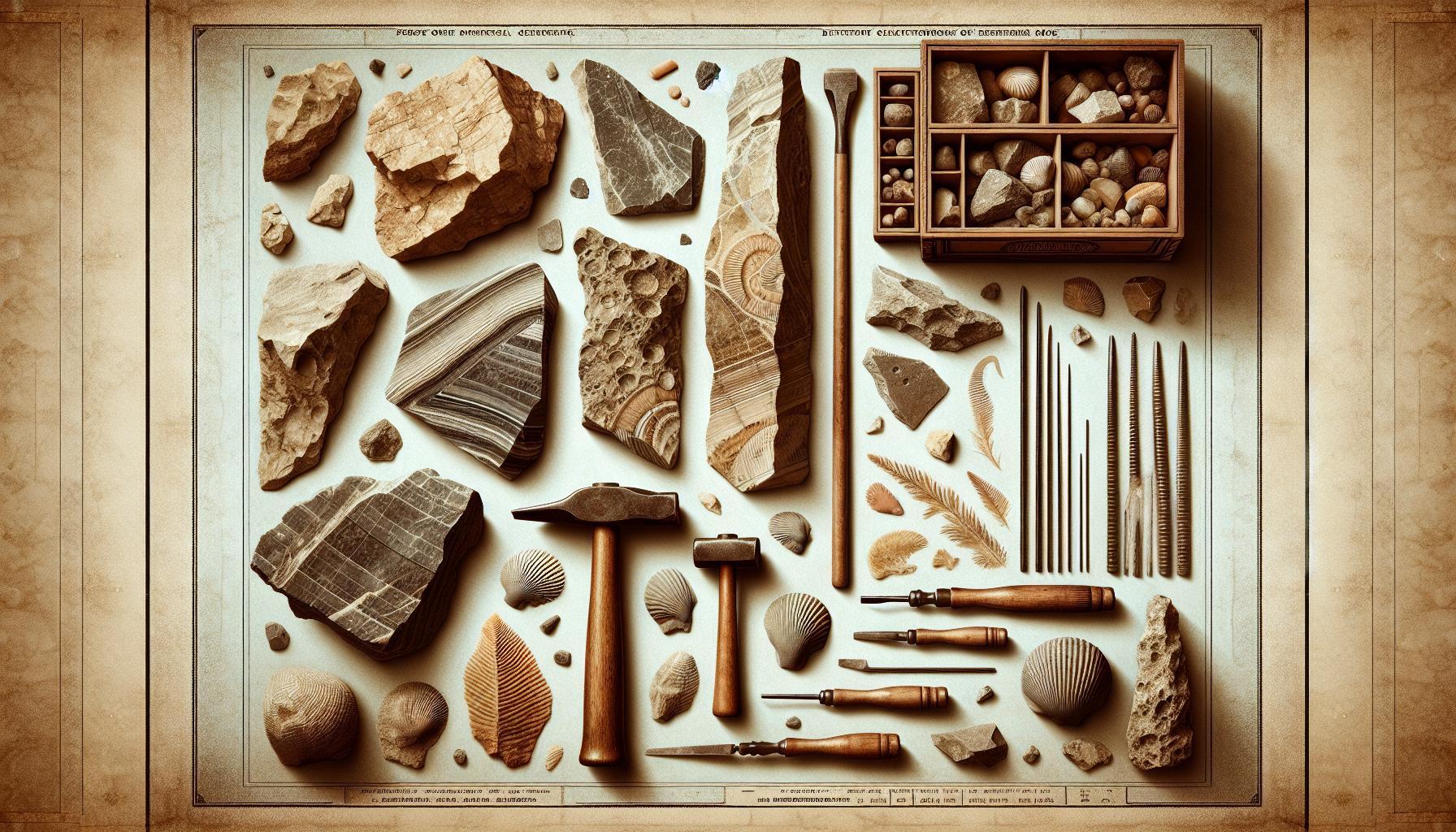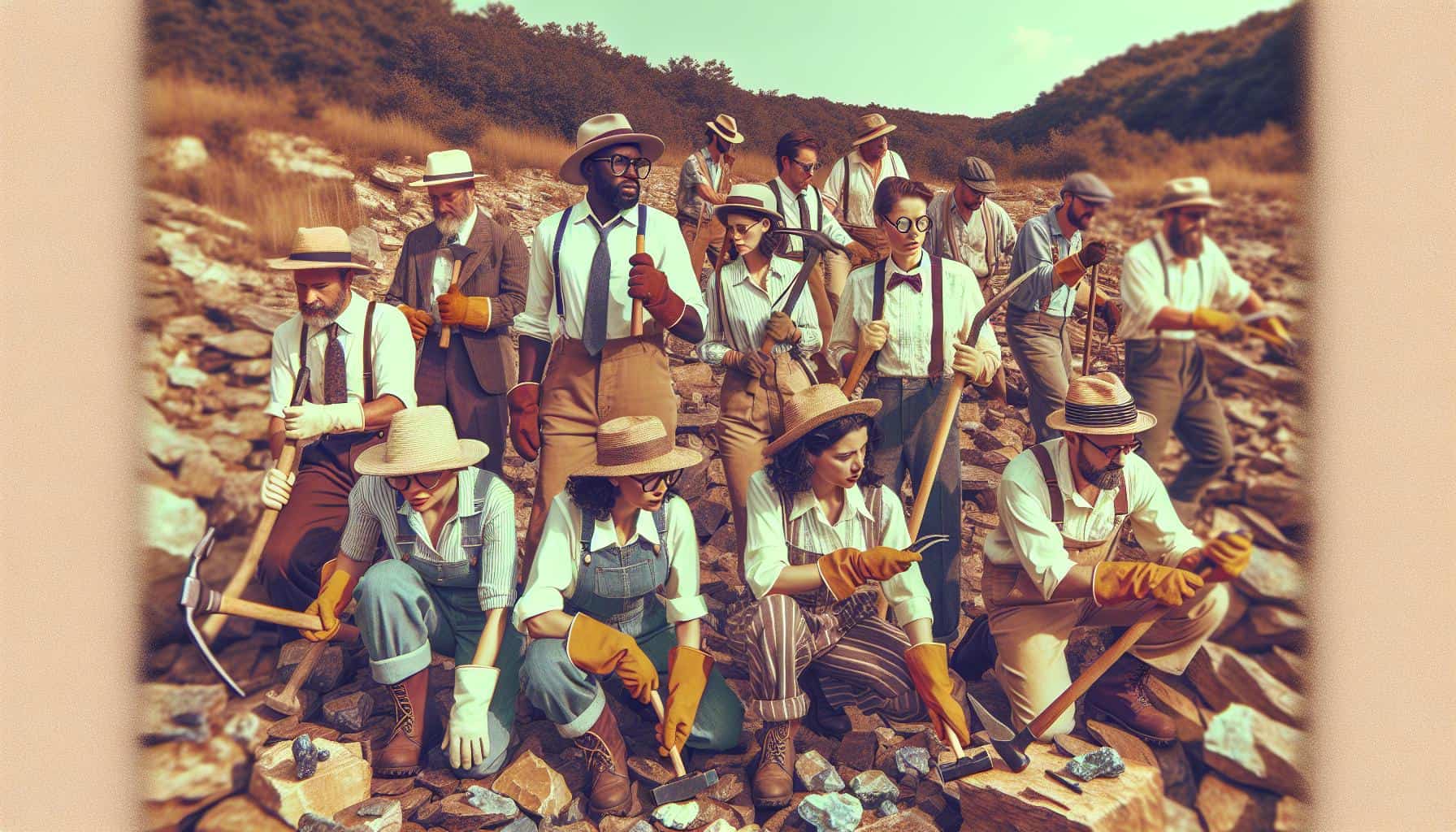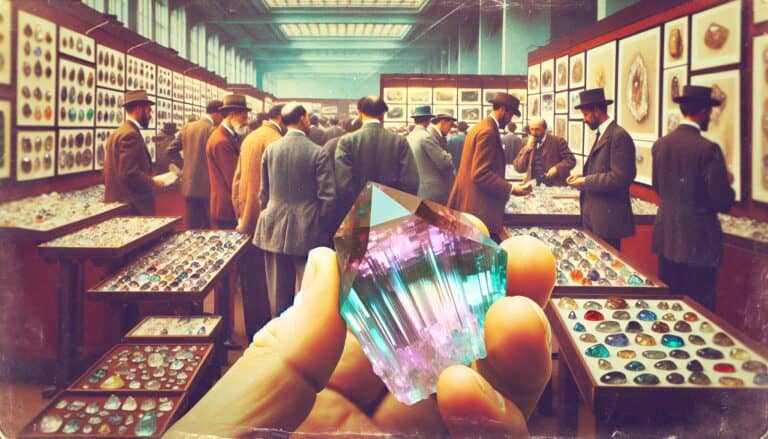Georgia’s diverse geology isn’t just a feast for the eyes; it’s a treasure trove for rockhounds like you.
From the ancient Appalachian Mountains to the coastal plains, the Peach State offers a variety of locales where you can dig into the earth’s rich history.
Whether you’re after the lustrous quartz or hunting for rare staurolite crystals, Georgia’s soil is ripe for the picking. You’ll find hidden gems, quite literally, scattered across the state waiting to be unearthed. Ready to explore the best spots for rockhounding and discover what unique specimens you can add to your collection?
Let’s get started.
In Georgia, key rockhounding sites include Graves Mountain for minerals, Hogg Mine for quartz and beryl, and Jackson’s Crossroads for amethysts. The North Georgia Mountains yield garnets, and Tybee Island offers fossils and shark teeth. Ensure local regulations are followed during exploration.
Get our FREE United States Rockhounding Map HERE

State of Georgia Rockhounding Locations
If you’re passionate about unearthing Georgia’s geological treasures, knowing where to start is key. Graves Mountain is a must-visit spot renowned for its abundance of minerals. Here, you’ll find rutile, pyrophyllite, kyanite, and even lazulite—the state gemstone.
Next on your list should be Hogg Mine, a pay-to-dig site where you’re likely to spot star rose quartz, black tourmaline, and beryl. Booking a dig allows you the thrill of discovering your own specimens in a controlled environment, perfect for beginners and seasoned rockhounds alike.
Jackson’s Crossroads is famous for its amethysts. The clarity and deep purple hue of the amethysts found here rival those from anywhere in the world. What’s more, the site offers regular digs, giving you the chance to add a few pieces to your collection.
The North Georgia Mountains shouldn’t be overlooked either. This area is a haven for rock collectors, with a rich variety of minerals resulting from the region’s ancient geological activity. You might stumble upon garnets, tourmalines, and even gold if you’re lucky.
For those who love beachcombing, Tybee Island’s shoreline can surprise you with fossils and shark teeth. While not your traditional rockhounding locale, the finds here are indicative of the area’s prehistoric past and are definitely worth the search.
When planning your rockhounding adventure, keep these nuggets in mind:
- Always seek permission if you’re entering private lands.
- Check for any regulations specific to the sites you’re visiting.
- Safety first—bring the right gear and never dig alone.
Remember, each location has a unique rockhounding experience, bursting with potential discoveries. Whether you’re an experienced rock collector or merely curious about geology, Georgia’s diverse sites offer an exciting and rewarding outdoor activity for everyone.
What Gemstones are Found in State of Georgia?

As you dive into Georgia’s rich geology, you’ll discover a fascinating array of gemstones beneath its surface. The state’s diverse geological formations make it a hotspot for enthusiasts looking to add to their collections.
Georgia is renowned for its stunning amethysts, coveted for their deep purple hues. These can primarily be found in abundance at locations like Jackson’s Crossroads, where the crystals are known for their exceptional clarity and size. When seeking amethyst, consider spring and fall seasons; times when quarry operations and clubs often plan digs open to the public.
Beyond amethyst, the Peach State also offers up sapient varieties of quartz like clear, smoky, and rose quartz – each with their own unique charm. Clear quartz, with its pure, crystalline beauty, is abundant and can be found at many sites, including the aforementioned Hogg Mine, which is also a renowned spot for star rose quartz.
Those on the hunt for something even rarer might be thrilled to find garnets and beryl. Garnets, known for their deep red color can be located in the North Georgia Mountains, a region rich with these precious gems. Beryl, which comes in an array of colors including green, blue, and yellow, is another exciting find for those visiting Hogg Mine.
| Gemstone | Notable Locations in Georgia | Colors |
|---|---|---|
| Amethyst | Jackson’s Crossroads | Deep Purple |
| Quartz | Hogg Mine, Various other sites | Clear, Smoky, Rose |
| Garnet | North Georgia Mountains | Deep Red |
| Beryl | Hogg Mine | Green, Blue, Yellow |
Equipped with this knowledge, you’re now better prepared to explore the myriad of sites across the state. Remember to pay heed to local regulations and respect the natural habitats you’ll be exploring. Happy hunting, and may your pockets be heavy with the gleam of Georgia’s natural treasures.
What Sedimentary Rocks You Can Find in State of Georgia?

While Georgia is renowned for its stunning quartz varieties, your rockhounding adventure isn’t complete without exploring the state’s rich collection of sedimentary rocks. Limestone and shale are two of the most common types you’ll encounter, remnants of ancient marine environments now etched into Georgia’s geological history.
If you set your sights on North Georgia, particularly the Valley and Ridge region, you’re likely to discover an abundance of limestone. This area was once covered by a shallow sea, leaving behind vast deposits. Limestone can appear dull, but don’t be fooled—these rocks may contain hidden marine fossils that offer a peek into primeval ocean life.
Heading south, you’ll find the Coastal Plain, a hotbed for sedimentary rock formations like kaolin. Georgia is one of the top producers of kaolin, a white, fine-grained clay used in various industries, from paper manufacturing to ceramics. Here, kaolin pits welcome rockhounds eager to unearth this soft, white sedimentary treasure.
Shale, although less glamorous than sparkling gemstones, holds a unique allure for fossil enthusiasts. With its fine layers, shale found in Georgia often contains plant imprints and animal traces that provide valuable insight into the state’s ancient environments.
For the sedimentary rock enthusiast, one simply can’t overlook the abundance of sandstone found in the Northwest Georgia region. Not only does sandstone present a warm palette of colors due to iron oxide staining, but it also frequents the list of Georgia’s geological wonders with its durability and aesthetic appeal in architecture.
Remember, while out in the field, always bring your rock hammer, chisel, and safety glasses. These tools are essential when looking to add sedimentary pieces to your collection—and who knows, your next strike could reveal a stunning fossil that’s been hidden for millions of years.
What Metamorphic Rocks are found in State of Georgia?
In Georgia, the quest for rocks and minerals isn’t restricted to just sedimentary and igneous varieties. You’ll also uncover a rich tapestry of metamorphic rocks, transformed under heat and pressure into new and fascinating forms.
Among the metamorphic treasures, schist and gneiss are prominent. These banded and foliated rocks arise from the intense alteration of original sedimentary or igneous materials. You’ll find these rocks, particularly in the northern regions of Georgia. There, the ancient roots of the Appalachian Mountains provide prime rockhounding locales. Schist often contains visible crystals of garnet, staurolite, and kyanite, adding to its appeal.
Marble, a metamorphosed form of limestone, is another gem in Georgia’s geological crown. The state’s marble is renowned for its purity and has been used in many historic buildings and monuments. The Pickens County area is a well-known source for this elegant rock.
In addition to these, soapstone, a soft rock composed primarily of the mineral talc, is abundant. It’s often found in areas with other metamorphic rocks like gneiss. Due to its heat-resistant properties, Native Americans once used Georgia’s soapstone to craft bowls and other tools.
Keep in mind that when searching for metamorphic rocks in Georgia, each location offers a unique mix of geological history and rock specimens. Always ensure you have the proper permissions to collect and familiarize yourself with the site specifics to enhance your rockhounding experience.
Here are some sites known for metamorphic rocks:
- The Tallulah Gorge area for schist and gneiss
- The Etowah River for sizeable marble deposits
- Soapstone outcrops near Tate City
Georgia’s varied metamorphic rocks not only provide a glimpse into the Earth’s transformative powers but also present an exciting challenge for rockhounds. Whether you’re a seasoned collector or a newbie, there’s always something new to discover beneath the Peach State’s surface.
What Igneous Rocks can You Find in State of Georgia?
Venturing into Georgia’s geological diversity, you won’t be disappointed by the variety of igneous rocks the state has to offer. Igneous rocks are formed from the solidification of molten magma and are a cornerstone of rockhounding adventures. In Georgia, granite is the predominant igneous rock; its durability and beauty make it a popular material for construction and monuments.
Granite Outcrops in Georgia
In particular, Stone Mountain is an iconic location, boasting one of the largest granite outcrops in the world. Here, you’ll observe the rock’s coarse-grained texture and its sparkling minerals, predominantly quartz, feldspar, and mica. Stone Mountain is not only a geological wonder but also an important recreational and historical site, offering more than just rockhounding prospects.
Other Interesting Igneous Finds
Besides granite, Georgia’s igneous repertoire includes:
- Pegmatite: This exceptionally coarse-grained rock is often found within granite and can harbor large crystals and rare minerals. Prospectors should keep an eye out for pockets of pegmatite, as they can sometimes contain gem-quality stones.
- Diorite: While less common, this coarse-grained igneous rock, composed mainly of plagioclase feldspar and hornblende, is an intriguing find. The Russell area and parts of the Piedmont region offer chances to unearth diorite samples.
- Basalt: Present in certain areas, this fine-grained rock is typically found in ancient volcanic terrains. Though not as widespread in Georgia, basalt is worth the search for those interested in the remnants of volcanic activity.
When scouting for igneous rocks, safety is paramount. Always ensure you’re equipped with proper gear and abide by local regulations. Remember, each site has its own set of rules, so prior research is essential. Additionally, consider the environment and strive to leave no trace of your visit behind, preserving the state’s natural beauty for future rockhounds.
Panning for Gold in State of Georgia
Gold panning in Georgia is not just a relic of the past; it’s an active hobby for many enthusiasts. Georgia was the site of the first major gold rush in U.S. history, predating California’s by nearly 20 years. Dahlonega, located in the heart of Georgia’s gold country, remains a hot spot for amateur gold panners.
Before heading out with your pan and shovel, it’s essential you’re aware of the laws and you have the necessary permission or permits. Public sites such as the Consolidated Gold Mine and Crisson Gold Mine offer tours and panning experiences. These mines guarantee visitors find genuine gold flakes and sometimes even small nuggets.
If you’re in for a more self-directed adventure, several rivers contain placer gold deposits. The Chattahoochee River, particularly around the National Recreation Area, is a favorite. Here’s a quick list of other promising rivers for gold panning:
- Etowah River
- Little River
- Chestatee River
- Tesnatee River
- Pigeon Creek
When panning, you’re on the lookout for the lustrous yellow metal, but you may also discover gemstones like quartz and garnets. Ensure you’re geared up with a durable pan, a classifier to sift through larger materials, and perhaps a sluice box to enhance your chances of striking it rich.
Remember, the best times to pan for gold are after a rainfall when the water has churned up the sediment laying on river beds. Also, early spring is ideal as the water levels are typically lower, exposing more of the stream bed.
Engaging in environmentally responsible panning is crucial. Don’t disturb the river banks, and refill any holes you dig. Preserving the pristine waterways of Georgia is just as significant as the treasures you may find.
Rocks and Minerals Found in State of Georgia
Georgia is a treasure trove for rockhounding enthusiasts, boasting a diverse range of rocks and minerals. Quartz is one of the most prevalent minerals found throughout the state. It’s not just any quartz—Georgia is renowned for its stunning amethyst varieties. This purple quartz can be a noteworthy find for both beginners and seasoned collectors.
Beryl crystals are another exciting discovery for rockhounds in Georgia. Varieties include Aquamarine and Emerald, with their respective captivating sea-green and deep green hues. These finds are more than just pretty rocks; they’re valuable for collectors and can be polished into beautiful gemstones.
If you’re aiming for something truly unique to Georgia, hunt for Staurolite crystals. These reddish-brown to black crystals are famous for their cross-shaped twins. Known colloquially as ‘fairy crosses’, they provide a mystical allure to your rock collection.
| Mineral | Common Locations | Color Varieties |
|---|---|---|
| Quartz | Throughout the state | Clear, Purple (Amethyst) |
| Beryl | Northern parts | Green, Sea-green |
| Staurolite | Northern Georgia | Reddish-brown, Black |
Bear in mind the vast geological diversity of Georgia as you plan your rockhounding trips. The northern region of the state is part of the Blue Ridge Mountain range which means you’ll find a range of metamorphic rocks that tell a story of intense pressure and heat. Garnet and Kyanite are two such gems you can encounter. Exploring further may lead you to rare finds of Corundum, the mineral responsible for rubies and sapphires.
Safety first—always wear proper gear and veer away from dangerous terrain. Respect landownership laws and obtain necessary permits when required. Remember, rockhounding isn’t just a hobby; it’s a way to connect with Earth’s natural history, so always tread lightly and leave no trace.
Happy hunting as you delve deeper into Georgia’s geological wonders. Keep your eyes peeled for the state’s coveted finds, and add some remarkable specimens to your collection.
Where Can I Find Fossils in State of Georgia?
Georgia is not only rich in crystals and minerals but also in ancient fossils that tell a story millions of years old. As a rockhound, you’re likely curious about where you can dig up a piece of Earth’s distant past. Fortunately, the Peach State offers numerous venues for fossil enthusiasts.
The coastal plains of Georgia are renowned for their fossil-rich deposits. Areas like the banks of the Flint River and the sandbars along the Chattahoochee River are hotspots for finding shark teeth and other marine fossils. In these locales, you may uncover a variety of fossilized remnants from Cretaceous to Miocene periods.
Savannah River is another prolific area ripe for fossil hunting. Here, you can expect to find ancient whale bones and a plethora of shark teeth, including those from the massive Megalodon shark that once dominated the seas.
Northwest Georgia, particularly the areas that were once part of ancient oceans, is known for its rich trilobite deposits. Trilobites are early arthropods—some of the oldest known fossils on Earth. Their fossilized remains provide a window into prehistoric marine life.
When searching for fossils, you must remain aware of the legal framework governing fossil collection in Georgia:
- Always obtain permission before collecting on private property.
- Fossil collection in state parks is often prohibited or strictly regulated.
- Research the areas you plan to visit and understand the local laws to ensure your fossil hunting complies with state regulations.
Remember to respect the environment by minimizing disruption to the surrounding area. Practice ethical fossil hunting by leaving smaller finds and using appropriate tools to collect your specimens.
State of Georgia Rockhounding Laws & Regulations
When you’re rockhounding in Georgia, it’s crucial to understand the laws and regulations governing this activity. Georgia has specific rules that ensure both the protection of geological sites and rockhounds’ safety.
Firstly, collecting on private property requires explicit permission from the landowner. Trespassing to hunt for rocks and minerals is against the law, and you’d be liable for any legal consequences. Make sure to secure permission in writing whenever possible to avoid any misunderstandings.
For public lands, such as state parks, rockhounding activities are generally allowed but with limitations. Removal of any natural resources may be restricted or require a permit. Check the rules of each park as they can vary significantly.
National forests in Georgia offer more lenient rockhounding opportunities. While you’re free to collect small amounts of rocks, minerals, and even fossils for personal use, commercial collection is not permitted. It’s essential to follow the U.S. Forest Service guidelines:
- Don’t use tools that could leave a significant impact on the land.
- Collect only what you can carry by hand.
- Avoid disturbing wildlife habitats.
The Georgia Department of Natural Resources (DNR) may require permits for fossil collection, especially in areas where paleontological research is active. The DNR aims to preserve important scientific sites, so be sure to contact them for the latest information on fossil collecting permits.
Georgia also has designated public collecting sites, specifically meant for rockhounding. These sites often have specific rules and may charge a fee. They typically offer a safe and legal way to enjoy rockhounding without the concern of violating private landowner rights or public land regulations.
Remember, laws and regulations are subject to change, and it’s your responsibility to keep updated. Respecting these ensures that rockhounding remains a sustainable hobby for you and others in the future.
Rockhounding Tips for Beginners in State of Georgia
Entering the world of rockhounding in Georgia is an exciting adventure. With the right approach and tools, you’ll be on your way to uncovering the state’s hidden geological treasures.
Gearing Up: Essential Tools for Rockhounding
Before heading out, make sure you’re well-prepared with the essential rockhounding tools. Rockhammers, chisels, and safety glasses are imperative for extracting specimens effectively and safely. A geologist’s hammer is particularly useful for breaking rocks without damaging what’s inside.
Gloves protect your hands while sifting through rough materials, and sturdy footwear ensures safe navigation across uneven terrains. Also, consider a backpack to carry your finds and a field guide to help identify them. Basic field tools might include:
- Hand lens or loupe
- Collection bags or buckets
- Notebook and pen for recording locations and details of finds
Having the right equipment not only makes your rockhounding experience more enjoyable but also increases your chances of finding well-preserved specimens.
Safety Tips While Rockhounding
Your safety during rockhounding cannot be overstated. Always inform someone about your trip details and expected return time. Hydration is crucial, so bring plenty of water, especially in the warmer months. Sun protection, like sunscreen and a hat, will guard against harmful UV rays during long hours in the field.
Keep a first aid kit handy for minor injuries, and know the basics of wildlife safety—beware of snakes and insects native to Georgia’s rockhounding sites. Avoid rockhounding alone if you’re a beginner, as having a partner can be invaluable in case of emergencies.
Legal Guidelines for Rockhounding Enthusiasts
Understanding the legalities of rockhounding ensures that you respect the environment and adhere to state regulations. Always seek permission before collecting on private property. When it comes to public lands and national forests, check if permits or fees are required for collecting.
Remember, taking artifacts from protected or historical sites is illegal. Always refer to the Georgia Department of Natural Resources for the latest in fossil collection permits and regulations. They are your go-to source for staying compliant with current laws.
By respecting these guidelines, you contribute to sustaining Georgia’s rich geological heritage while enjoying the rewards of a conscientious rockhound.
Conclusion: Georgia Rockhounding Map
Embarking on your rockhounding adventure in Georgia, you’re now armed with the knowledge to make your journey both enjoyable and responsible.
Remember, the right gear will not only enhance your experience but also ensure your safety as you uncover Georgia’s geological treasures. With your due diligence on legalities and environmental care, you’re set to explore the rich terrain responsibly.
Always stay informed on the latest regulations and happy hunting!



![Idaho Rockhounding Sites in [year]: Top Spots & Treasures](https://observationhobbies.com/wp-content/uploads/2024/01/1nS3_lIxMswz4degrvb9n-768x439.jpg)



